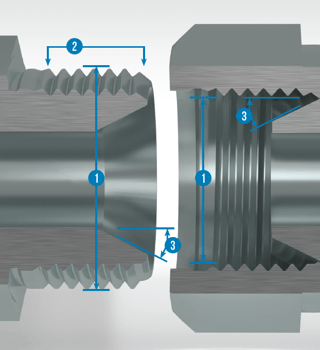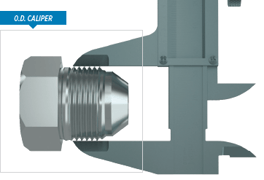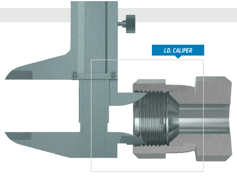Identifying and selecting the correct fluid and gas connectors before installation is crucial. This post provides an overview of our Thread ID & Measurement Guide. We will cover some common hydraulic transfer lines, piping and instrumentation systems and the steps to measure threads in the field.
Measure Threads
1.) First, use an O.D./I.D. caliper to measure the diameter of the threads. If you are measuring a used fitting and the threads are worn, consider replacing it as damaged threads are likely to leak. 
2.) Next, place the teeth into the fitting threads using a thread pitch gauge until it fits snugly to find an accurate measurement of the number of threads per inch. For metric fittings, measure the distance between the threads instead. Then, refer to a thread chart to confirm your measurements.
3.)If the female port is tapered, use a gauge on the sealing surface to establish the seat angle. To ensure a proper measurement, the gauge must be parallel with the centerline of the fitting.
Using Your Tools and Thread Charts
Measurement Tools
Fitting threads are measured using three tools:
- I.D./ O.D. caliper
- Seat angle gauge
- Thread pitch gauge
There are many styles of analogue and digital thread measuring tools. Digital devices will tend to provide more precise readings. However, many prefer to use analog tools which are often more conducive for use in the field. Many thread measuring tools incorporate a seat angle gauge and caliper in one tool, making it faster and easier to switch between measurements.

 An I.D./O.D. caliper measures the I.D. of a female thread and O.D. of a male thread. If measuring a used fitting, be sure to check for any thread distortion before measuring and comparing thread gauge measurements to a thread chart. Threads that have been in-service may show inaccurate comparison between the measurement and the thread tables, and it’s likely best to replace the fitting. Using fittings with distorted threads may leak and cause system failure.
An I.D./O.D. caliper measures the I.D. of a female thread and O.D. of a male thread. If measuring a used fitting, be sure to check for any thread distortion before measuring and comparing thread gauge measurements to a thread chart. Threads that have been in-service may show inaccurate comparison between the measurement and the thread tables, and it’s likely best to replace the fitting. Using fittings with distorted threads may leak and cause system failure.
Seat angle gauge: The angles of the gauge and seat will match when the centerline of the seat gauge is parallel to the lengthwise axis of the fitting.
Measuring Threads
When using a thread pitch gauge, make sure the teeth on the gauge are snug to the threads. Once the thread pitch is identified, use an I.D./ O.D. caliper to measure the thread diameter and make sure the measurement corresponds to a thread chart.
For fittings such as JIC, NPT, BSP and others, the thread pitch gauge measures threads per inch. Comparatively, for metric threads such as the German DIN the gauge is used to measure the distance between threads
Measuring Surface Angles
To measure correct angle in female ports, insert the ID section of the gauge into the threads in the sealing surface of the connection and make sure the centerline of the fitting is parallel to the gauge.
As with female ports, when measuring the thread surface angle of male fittings align the gauge on the thread’s sealing surface and ensure the centerline and gauge are parallel.
Conclusion – Fitting Selection
It is important to follow the manufacturers’ recommendations and specifications when selecting fitting connections. Make sure not to mix fittings from different manufacturers. Though they may have the same specs, it’s always possible that slight variations can keep you from having a positive connection-- which can result in leaks and premature system failure. Corrective maintenance costs will always exceed the cost of a fitting.
Additionally, there is a high potential of leaks or release of high-pressure fluid or gas if the manufacturer’s pressure rating is exceeded, causing system failure and serious injury. Excess pressure can lead to a higher torque drag and premature wear of all inline components.
It's also imperative to make sure the fitting material is compatible with the chemical composition of the fluid, system temperature and the external environment. Carbon steel is a good choice for many applications, yet stainless steel is best for highly corrosive applications, especially at extreme pressure and temperature.
When using fittings with O-rings and other seals, make sure they are compatible with the inline fluid or gas and rated for exposure to the external temperature and environment. Many O-ring fittings are the best choice in certain high-pressure applications, often capable of withstanding working pressures up to 6000 psi. These fittings, such as O-ring boss or O-ring face seal are often the best choice in applications experiencing frequent mechanical shock.

